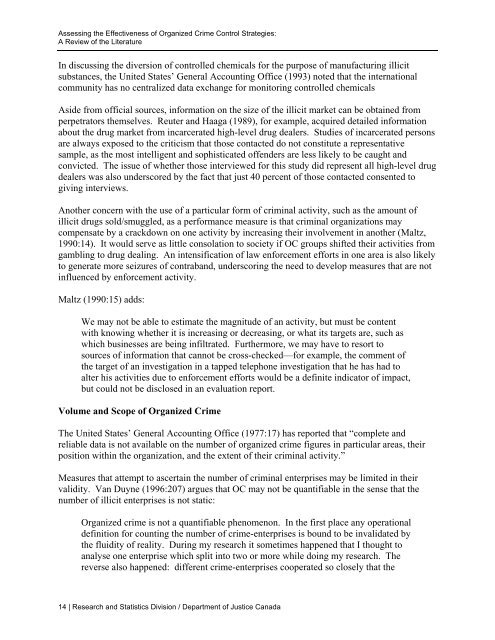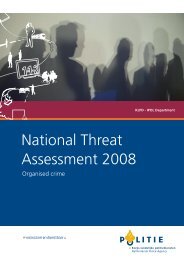Assessing the Effectiveness of Organized Crime Control Strategies ...
Assessing the Effectiveness of Organized Crime Control Strategies ...
Assessing the Effectiveness of Organized Crime Control Strategies ...
Create successful ePaper yourself
Turn your PDF publications into a flip-book with our unique Google optimized e-Paper software.
<strong>Assessing</strong> <strong>the</strong> <strong>Effectiveness</strong> <strong>of</strong> <strong>Organized</strong> <strong>Crime</strong> <strong>Control</strong> <strong>Strategies</strong>:<br />
A Review <strong>of</strong> <strong>the</strong> Literature<br />
In discussing <strong>the</strong> diversion <strong>of</strong> controlled chemicals for <strong>the</strong> purpose <strong>of</strong> manufacturing illicit<br />
substances, <strong>the</strong> United States’ General Accounting Office (1993) noted that <strong>the</strong> international<br />
community has no centralized data exchange for monitoring controlled chemicals<br />
Aside from <strong>of</strong>ficial sources, information on <strong>the</strong> size <strong>of</strong> <strong>the</strong> illicit market can be obtained from<br />
perpetrators <strong>the</strong>mselves. Reuter and Haaga (1989), for example, acquired detailed information<br />
about <strong>the</strong> drug market from incarcerated high-level drug dealers. Studies <strong>of</strong> incarcerated persons<br />
are always exposed to <strong>the</strong> criticism that those contacted do not constitute a representative<br />
sample, as <strong>the</strong> most intelligent and sophisticated <strong>of</strong>fenders are less likely to be caught and<br />
convicted. The issue <strong>of</strong> whe<strong>the</strong>r those interviewed for this study did represent all high-level drug<br />
dealers was also underscored by <strong>the</strong> fact that just 40 percent <strong>of</strong> those contacted consented to<br />
giving interviews.<br />
Ano<strong>the</strong>r concern with <strong>the</strong> use <strong>of</strong> a particular form <strong>of</strong> criminal activity, such as <strong>the</strong> amount <strong>of</strong><br />
illicit drugs sold/smuggled, as a performance measure is that criminal organizations may<br />
compensate by a crackdown on one activity by increasing <strong>the</strong>ir involvement in ano<strong>the</strong>r (Maltz,<br />
1990:14). It would serve as little consolation to society if OC groups shifted <strong>the</strong>ir activities from<br />
gambling to drug dealing. An intensification <strong>of</strong> law enforcement efforts in one area is also likely<br />
to generate more seizures <strong>of</strong> contraband, underscoring <strong>the</strong> need to develop measures that are not<br />
influenced by enforcement activity.<br />
Maltz (1990:15) adds:<br />
We may not be able to estimate <strong>the</strong> magnitude <strong>of</strong> an activity, but must be content<br />
with knowing whe<strong>the</strong>r it is increasing or decreasing, or what its targets are, such as<br />
which businesses are being infiltrated. Fur<strong>the</strong>rmore, we may have to resort to<br />
sources <strong>of</strong> information that cannot be cross-checked—for example, <strong>the</strong> comment <strong>of</strong><br />
<strong>the</strong> target <strong>of</strong> an investigation in a tapped telephone investigation that he has had to<br />
alter his activities due to enforcement efforts would be a definite indicator <strong>of</strong> impact,<br />
but could not be disclosed in an evaluation report.<br />
Volume and Scope <strong>of</strong> <strong>Organized</strong> <strong>Crime</strong><br />
The United States’ General Accounting Office (1977:17) has reported that “complete and<br />
reliable data is not available on <strong>the</strong> number <strong>of</strong> organized crime figures in particular areas, <strong>the</strong>ir<br />
position within <strong>the</strong> organization, and <strong>the</strong> extent <strong>of</strong> <strong>the</strong>ir criminal activity.”<br />
Measures that attempt to ascertain <strong>the</strong> number <strong>of</strong> criminal enterprises may be limited in <strong>the</strong>ir<br />
validity. Van Duyne (1996:207) argues that OC may not be quantifiable in <strong>the</strong> sense that <strong>the</strong><br />
number <strong>of</strong> illicit enterprises is not static:<br />
<strong>Organized</strong> crime is not a quantifiable phenomenon. In <strong>the</strong> first place any operational<br />
definition for counting <strong>the</strong> number <strong>of</strong> crime-enterprises is bound to be invalidated by<br />
<strong>the</strong> fluidity <strong>of</strong> reality. During my research it sometimes happened that I thought to<br />
analyse one enterprise which split into two or more while doing my research. The<br />
reverse also happened: different crime-enterprises cooperated so closely that <strong>the</strong><br />
14 | Research and Statistics Division / Department <strong>of</strong> Justice Canada








